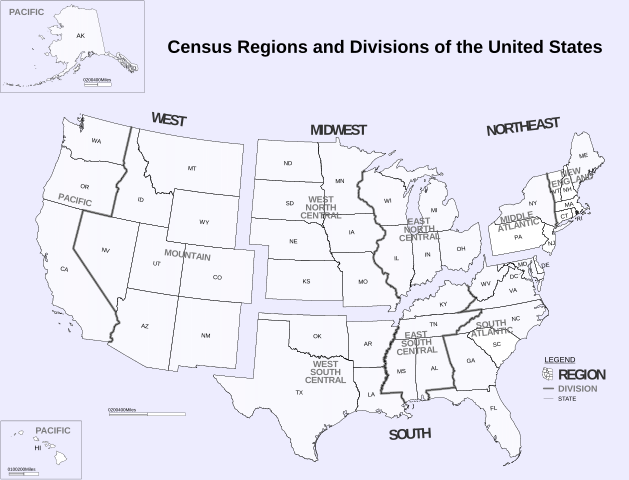
For years, the US South has done very well in net domestic migration (moving into the region from another region of the United States. Since the 2020 census, only the South region gained net domestic migrants, as the other three regions, the Northeast, Midwest and West have all lost residents to other regions.

Census Regions
Over the past four years (July 2020 to July 2024), the South gained 2,685,000 net domestic migrants. This included strong gains in Florida, Texas, North Carolina, South Carolina and Tennessee.
All of the other three census regions lost domestic migrants.The second best regional performance was in the Midwest, which lost 494,000 net domestic migrants. Nearly all of this loss was in the East North Central, which includes Ohio, Michigan, Indiana, Illinois and Wisconsin. The West ranked third in net domestic migration, losing 978,000. The last place was taken by the Northeast, which lost 1,186,000 net domestic migration.
Census Divisions
There are nine census divisions, two in each of the regions, with the exception that there are three in the South region. Four census divisions gained net domestic migrants, while five sustained losses. The table below shows data by census region, census division and state/DC.
Census Divisions in the South
The South Atlantic division (Atlantic coast states from Maryland south) had the largest net domestic migration gain, at 1,579,000. Florida had the largest gain, at 810,000, followed by North Carolina (384,000), South Carolina (300,000), Tennessee (237,000) and Georgia (194,000). Only the states of Maryland (115,0000) and Virginia (35,000) had net domestic migration losses over the period, as did the District of Columbia (14,000).
The West South Central division gained the second most net domestic migrants, at 725,000. This includes Texas (694,000), Oklahoma (89,000) and Arkansas (66,000), while Louisiana lost 124,000.
The East South Central division ranked fourth nationally, with a net domestic migration gain of 354,000. Much of this gain was in Tennessee and Alabama (109,000), with a smaller gain in Kentucky (28,000) and a loss in Mississippi (minus 20,000).
Census Divisions in the West Region
The only census division outside the South to gain net domestic migrants was the Mountain west, with a gain of 525,000. Arizona gained 222,000, Idaho 111,000. Nevada 71,000, Montana 51,000,Utah 47,000 and Colorado 24,000 and Wyoming 7,000. New Mexico lost 9,000.
The other census division in the West, the Pacific had the greatest net domestic migration loss in the US. Fueled principally by California, the losses are also being sustained in the other Pacific states, spreading in Oregon, Washington, Alaska and Hawaii. The largest loss in the nation was in California, which accounted for 1,398,000. Hawaii lost 46,000. Washington 34,000, Alaska 18,000 and Oregon 8,000.
Census Divisions in the Midwest Region
The West North Central division had the smallest loss in the nation, at 31,000. The best performing state was South Dakota, which had a 21,000 gain. All of the other states had losses, with North Dakota losing 6,000, Iowa losing 8,000, Nebraska losing 13,000, Kansas losing 20,000 . By far the biggest loser was Minnesota, at 47,000).
The other Midwest division, the East North Central, lost 463,000 net domestic migrants. Indiana did best, gaining 29,000, while Wisconsin gained 3,000. Ohio lost 35,000, Michigan 63,000 and Illinois 396,000. The Illinois loss was greater than all states, with the exception of California and New York.
Census Divisions in the Northeast Region
The second largest divisional net domestic migration loss was in the Middle-Atlantic, at 1,122,000. Much of this was in New York at 894,000, which was a larger loss than any state but California. The other two Middle-Atlantic states also lost net domestic migrants, including New Jersey 183,000 and Pennsylvania 45,000.
The other division in the Northeastern region, New England , had the second smallest divisional loss. Maine had the largest gain, at 47,000. New Hampshire gained 28,000 and Vermont gained 6,000. Massachusetts lost 134,000 net domestic migrants, Rhode Island 8,000 and Connecticut 4,000. Without these three states, New England is gaining net domestic migrants.
The Trend
As people continue to move away from areas with higher urban densities to ones with lower urban densities (see: More on the Flight from Density: Within Major Metropolitan Areas). This is particularly evident in the northern New England gains, the stronger gains in some Mountain states and in the South.
Wendell Cox is principal of Demographia, an international public policy firm located in the St. Louis metropolitan area. He is a Senior Fellow with the Frontier Centre for Public Policy in Winnipeg and a member of the Advisory Board of the Center for Demographics and Policy at Chapman University in Orange, California. He has served as a visiting professor at the Conservatoire National des Arts et Metiers in Paris. His principal interests are economics, poverty alleviation, demographics, urban policy and transport. He is co-author of the annual Demographia International Housing Affordability Survey and author of Demographia World Urban Areas.
Mayor Tom Bradley appointed him to three terms on the Los Angeles County Transportation Commission (1977-1985) and Speaker of the House Newt Gingrich appointed him to the Amtrak Reform Council, to complete the unexpired term of New Jersey Governor Christine Todd Whitman (1999-2002). He is author of War on the Dream: How Anti-Sprawl Policy Threatens the Quality of Life and Toward More Prosperous Cities: A Framing Essay on Urban Areas, Transport, Planning and the Dimensions of Sustainability.
Photo: Looking toward Tallahassee Capitol building via Flickr under CC 2.0 License.
Table back to reference.
| SUMMARY OF NET DOMESTIC MIGRATION July 2020 to July 2024 |
||
| CENSUS REGIONS | Net Domestic Migration | Rank |
| Northeast Region | -1,186,027 | 4 |
| Midwest Region | -494,057 | 2 |
| South Region | 2,658,499 | 1 |
| West Region | -978,415 | 3 |
| CENSUS DIVISIONS | Net Domestic Migration | Rank |
| New England | -63,940 | 6 |
| Middle Atlantic | -1,122,087 | 8 |
| East North Central | -462,579 | 7 |
| West North Central | -31,478 | 5 |
| South Atlantic | 1,579,240 | 1 |
| East South Central | 354,378 | 4 |
| West South Central | 724,881 | 2 |
| Mountain | 524,794 | 3 |
| Pacific | -1,503,209 | |
| STATES | Net Domestic Migration | Rank |
| Alabama | 109,375 | 9 |
| Alaska | -17,930 | 34 |
| Arizona | 222,465 | 6 |
| Arkansas | 66,039 | 12 |
| California | -1,397,897 | 50 |
| Colorado | 23,807 | 21 |
| Connecticut | -3,522 | 27 |
| Delaware | 44,125 | 16 |
| Florida | 810,122 | 1 |
| Georgia | 193,886 | 7 |
| Hawaii | -46,018 | 41 |
| Idaho | 111,459 | 8 |
| Illinois | -395,721 | 48 |
| Indiana | 28,556 | 18 |
| Iowa | -8,251 | 30 |
| Kansas | -22,041 | 36 |
| Kentucky | 27,734 | 20 |
| Louisiana | -124,444 | 45 |
| Maine | 47,322 | 14 |
| Maryland | -114,948 | 44 |
| Massachusetts | -133,608 | 46 |
| Michigan | -63,064 | 43 |
| Minnesota | -46,516 | 42 |
| Mississippi | -20,099 | 35 |
| Missouri | 43,293 | 17 |
| Montana | 50,720 | 13 |
| Nebraska | -12,996 | 33 |
| Nevada | 70,963 | 11 |
| New Hampshire | 27,898 | 19 |
| New Jersey | -183,099 | 47 |
| New Mexico | -8,713 | 32 |
| New York | -893,537 | 49 |
| North Carolina | 383,851 | 3 |
| North Dakota | -6,012 | 28 |
| Ohio | -35,266 | 39 |
| Oklahoma | 89,307 | 10 |
| Oregon | -7,602 | 29 |
| Pennsylvania | -45,451 | 40 |
| Rhode Island | -8,258 | 31 |
| South Carolina | 299,962 | 4 |
| South Dakota | 21,045 | 22 |
| Tennessee | 237,368 | 5 |
| Texas | 693,979 | 2 |
| Utah | 47,233 | 15 |
| Vermont | 6,228 | 25 |
| Virginia | -34,634 | 38 |
| Washington | -33,762 | 37 |
| West Virginia | 11,089 | 23 |
| Wisconsin | 2,916 | 26 |
| Wyoming | 6,860 | 24 |
| DISTRICT OF COLUMBIA | Net Domestic Migration | |
| District of Columbia | -14,213 | |












